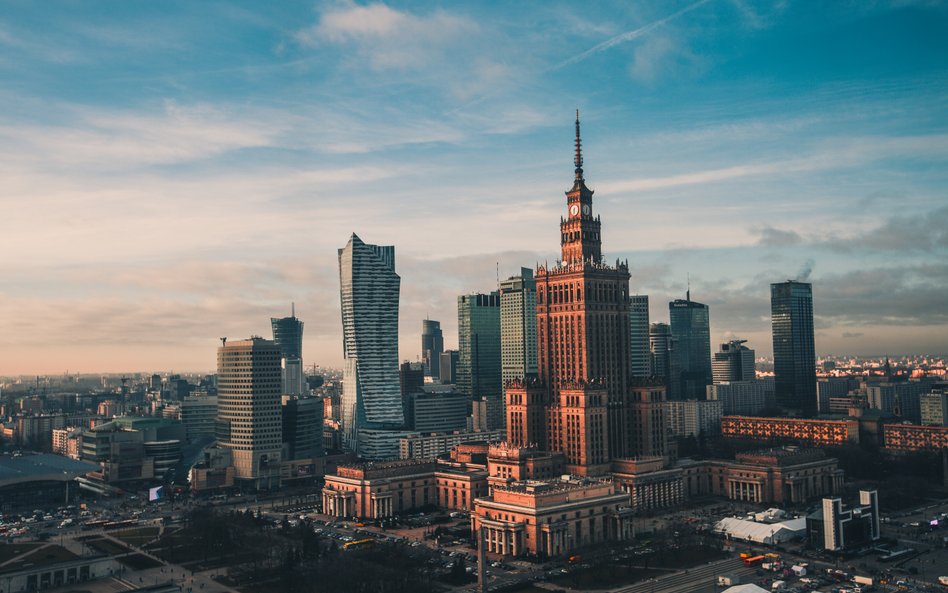Introduction:
Poland is embarking on an unprecedented infrastructure and defense spending boom that is reshaping its economy – and its labor market. Massive projects like a new national transport hub and high-speed rail network, alongside record defense procurements, are creating surging demand for engineers, construction crews, and manufacturing specialists. Unemployment in Poland hovers around multi-decade lows, raising the stakes for businesses scrambling to secure skilled talent1. As billions of euros flood into rail lines, airports, tanks and factories, companies are turning to creative staffing solutions – including temporary and foreign workers – to keep these mega-projects on track.
Rail and Infrastructure Mega-Projects Reshaping Poland
Poland’s government has launched one of Europe’s largest infrastructure programs, headlined by the new Centralny Port Komunikacyjny (CPK) – a combined airport and railway hub between Warsaw and Łódź. Backed by a PLN 131.7 billion budget through 2032, the CPK project will include a major international airport and 1,800 km of new high-speed rail lines linking cities across the country2. After recent schedule updates, the first phase – featuring the airport and core rail connections – is slated to open by end of 2032. This “Solidarity Transport Hub” is designed to slash travel times (e.g. Warsaw to Łódź in ~40 minutes) and handle up to 34 million passengers annually in its initial phase . Surrounding the airport, new logistics parks, road upgrades and commercial zones are planned, multiplying the project’s economic impact.
Not only is CPK a transport game-changer – it’s also a massive job creator. Construction of the airport, rail lines and roads is expected to create around 150,000 jobs, from construction workers and engineers to planners and support staff. Government analyses with Kearney project that by 2040, the operational hub (airport + rail) could sustain nearly 300,000 jobs when indirect effects are included . Crucially, these benefits will be spread nationwide: CPK’s rail investments involve 12 new routes (“spokes”) reaching every region, giving a boost to local contractors and suppliers far beyond Warsaw3. By integrating currently rail-deprived cities into the network, the project aims to “finally restore rail to many regions in Poland,” notes CPK’s rail investment chief4. In total, tenders worth some PLN 30 billion for CPK-related works (the airport terminal, railway lines, access roads) are scheduled by the end of 2025 – signaling enormous long-term opportunities for construction and transport firms.
Beyond CPK, Poland is modernizing existing railroads on a scale not seen in decades. State rail company PKP PLK is deploying EU funds and loans to upgrade hundreds of kilometers of track, stations, and signaling systems. For example, a recent €450 million EIB loan will help modernise 120 km of a key southern line, with PKP PLK launching almost PLN 30 billion in new tenders to accelerate rail improvements5. Major lines like the Warsaw–Gdańsk and east–west corridors are being overhauled to increase train speeds and capacity. These upgrades, coupled with new high-speed lines from the CPK programme, are set to keep Poland’s rail construction sector busy through the 2020s. Industry experts describe an oncoming “infrastructure investment peak” around 2025–26, as huge public projects in rail, roads, energy and more all kick into high gear simultaneously. While this construction boom promises better connectivity and growth, it also raises a pressing question: who will build it all, given Poland’s tightening labor pool?
Defense Procurement Drive and Industrial Expansion
In parallel with its civil infrastructure push, Poland is undertaking one of the most ambitious military modernization efforts in NATO. Spurred by security concerns after Russia’s invasion of Ukraine, Polish defense spending has skyrocketed to around 4% of GDP, the highest level among NATO countries . Plans are in place to boost this further – up to 4.7% of GDP in 2025 – as Poland races to strengthen its armed forces. The government’s 2022 Homeland Defence Act paved the way for the military’s expansion from about 120,000 active personnel to 300,000 troops by 2035, a nearly 50% increase in manpower6. Achieving that goal involves an intense recruitment drive and the creation of new divisions, all of which will require training, housing, and support staff on a large scale.
At the same time, Poland has opened the floodgates on defense procurement. It has “purchased over a thousand new tanks and 600 artillery pieces, mainly from South Korea and the US,” in the past two years alone. These include modern K2 Black Panther tanks and K9 Thunder self-propelled howitzers from South Korea, M1 Abrams tanks and HIMARSrocket systems from the United States, as well as F-35 fighter jets7. Many of these deals come with foreign partnerships and technology transfers. Notably, of the ~1,000 K2 tanks on order, up to 820 will be produced in Poland under license over the next decade – a boost for local manufacturing. Polish defense contractors, led by the state-owned Polish Armaments Group (PGZ), are expanding capacity to assemble, maintain, and eventually develop advanced weaponry domestically. For example, PGZ has secured PLN 2.4 billion (~€566 million) in government funding to build three new ammunition factories, aiming to ramp up output of 155mm artillery shells from 20,000 to as much as 150,000+ per year by 202 . This investment not only strengthens NATO’s eastern flank but is also “boosting Poland’s industrial base and local employment,” as an industry brief noted. New munitions plants and expansions at PGZ subsidiaries (like Dezamet, Mesko and Nitro-Chem) are expected to create hundreds of specialized manufacturing jobs, positioning Poland as a key ammunition supplier in Europe.
Poland’s defense buildup includes investing in domestic arms production. Here, 155mm artillery shells on a Polish production line, part of efforts to quintuple annual output by 2027 .
From tank assembly lines to maintenance depots and logistics, the defense boom is rippling through regional labor markets. Many of the new facilities are planned in smaller cities – for instance, a major hub for servicing Abrams tanks is set in Poznań, and the expanded ammunition plants will be spread across at least three provinces. These projects demand not only engineers and metalworkers, but also a surge of skilled trade workers, safety experts, and project managers. Local technical universities and vocational schools are seeing growing interest in defense-related fields. And just as in the civil sector, defense contractors are likely to rely on subcontractors and temporary staffing to handle spikes in workload when big orders come through.
Workforce Challenges in an Overheated Labor Market
All these investments are colliding with one of the tightest labor markets in Europe. Poland’s unemployment rate stands near 5%, around its lowest level on record and one of the lowest in the EU. In May 2024 the registered jobless rate hit 5% – a reflection of strong economic growth and earlier emigration outflows easing – and it hasn’t climbed significantly since8. While a low jobless rate is good news generally, it also means labor shortages are acute. Employers across sectors report difficulty hiring, from IT specialists to truck drivers and factory workers. In fact, an estimated 110,000 positions are currently unfilled in Poland, according to government data, with construction, transport, manufacturing, and healthcare among the most affected fields. Demographic trends compound the challenge: a rapidly aging population and years of declining birth rates have begun shrinking the native workforce, a trend experts warn will accelerate into the 2030s.
Nowhere are worker shortages felt more sharply than in construction and engineering – the very trades needed for Poland’s infrastructure and defense ventures. The construction sector in particular faces a demographic crunch. A recent industry report highlighted that before 2022, about 30% of construction workers in Poland were Ukrainian; many have since left, either returning home to fight or seeking opportunities in Western Europe. “A big problem in Poland today is the availability of skilled labour, but also manual workers. We do not have access to workers from Ukraine today and the availability of human resources is limited,” said the director of a major Polish construction firm9. This exodus has left Polish builders scrambling to find replacements just as huge rail and road contracts are rolling out. Fewer young Poles are entering technical trades as well – enrollment in construction and engineering courses has fallen in recent years – meaning the domestic pipeline of skilled labor is struggling to keep up with demand.
Flexible Staffing and Immigration as Solutions
To overcome these workforce bottlenecks, Polish companies and policymakers are increasingly turning to flexible employment models and immigration. One notable trend is the reliance on temporary and contract workers. Around 14.8% of employees in Poland are on temporary contracts, above the EU average of ~12% . This high share of temporary employment – although down from peaks a decade ago – indicates that many businesses use short-term staff to stay agile. For the CPK project and others, firms are expected to bring in contractors for specialized tasks (e.g. tunneling experts, IT systems installers) and to meet peak labor needs during intense construction phases. Temporary staffing agencies report strong demand from construction and logistics companies gearing up for these projects. By using contracted workers, companies can scale manpower up or down as project timelines require, without facing long-term payroll commitments. It’s a strategy to maintain flexibility given the finite duration of mega-projects. As one workforce consultant noted, flexible staffing allows projects “to support these mega-projects without bloating permanent headcounts, then redeploy workers to the next big project as needed” – a crucial advantage in Poland’s tight labor environment.
Another key piece of the puzzle is foreign labor. Poland has already become a leading destination for migrant workers in Europe – about 1.2 million foreigners (over 7% of the labor force) were working in Poland as of late 2024, the majority from neighboring Ukraine and Belarus. This helped plug some gaps, for example in lower-skilled construction and agriculture jobs. But with many Ukrainians potentially returning home for post-war rebuilding in the coming years, Polish employers are seeking new sources of talent abroad. Business groups are lobbying Warsaw to further open the doors to legal immigration. In August 2024, a coalition of 11 major employers’ federations issued an open letter urging a “welcoming approach to sustainable labour immigration” to address Poland’s “crippling labour shortages”. They warn that without more foreign workers, sectors like IT (which reportedly needs 150,000 additional specialists) and transport (short tens of thousands of drivers) will struggle to maintain growth10. The government has responded with some facilitation – for instance, simplifying work visa processes for certain skilled professions and signing labor agreements with countries like the Philippines and Kazakhstan. Immigration alone won’t solve the skills gap, but it’s poised to remain an important pressure valve for Poland’s labor market as the big projects move forward.
Looking ahead, Poland’s infrastructure and defense boom presents a classic double-edged sword for the labor market. On one hand, these investments will generate economic growth, regional development, and tens of thousands of new jobs. On the other hand, they risk overheating an already tight labor supply, which could drive up wages and project costs unless managed carefully. Human capital has become just as critical as financial capital in delivering Poland’s ambitious plans. Business and government leaders are therefore focused on training and upskilling initiatives – from railway engineering programs to welding apprenticeships – to build the talent pipeline. Some of CPK’s contractors have partnered with technical schools to train future rail technicians, and the Polish Armaments Group is offering internships to attract young workers to the arms industry.
For HR managers and operations leaders, the takeaway is clear: Poland’s economic trajectory for the next decade will be defined by big builds and the race to staff them. Those who can adapt with flexible workforce strategies, tap into new labor pools, and invest in skill development will be best positioned to seize the opportunities of this boom. In many ways, Poland is experiencing growing pains on its path to modernization – a high-class problem of having “too many” investments and not enough workers. By creatively leveraging temporary employment, welcoming international talent, and upskilling its people, Poland aims to ensure that cranes keep swinging, assembly lines keep rolling, and its bold infrastructure and defense plans become reality on schedule.
Sources:
- EURES — “Labour Market Information: Poland,” European Commission, Feb 24, 2025 — https://eures.europa.eu/living-and-working/labour-market-information-europe/labour-market-information-poland_en; Trading Economics — “Poland Job Vacancy Rate,” Q1 2025 — https://tradingeconomics.com/poland/job-vacancy-rate). ↩︎
- Anna Koper, Reuters — “Poland’s huge air hub plan to go ahead, says PM,” Jun 26, 2024 — https://www.reuters.com/world/europe/polands-huge-air-hub-plan-go-ahead-says-pm-2024-06-26/). ↩︎
- Lubomir Cech, Railmarket News — “CPK: EUR 18 billion for development of high-speed railway in Poland,” Jan 1, 2025 — https://railmarket.com/news/infrastructure/28077-cpk-eur-18-billion-for-development-of-high-speed-railway-in-poland). ↩︎
- CPK — “STH: words turned into actions…” news page, citing 1,789 km/12 routes and job effects — https://www.cpk.pl/en/news/sth-words-turned-into-actions-adviser-from-the-far-east-and-railway-investment-plan-for-2020-2035). ↩︎
- Dentons client alert — “CPK: Tenders for around PLN 30 billion this year,” May 7, 2025 — https://www.dentons.com/en/insights/alerts/2025/may/7/cpk-tenders-for-around-pln-30-billion-this-year). ↩︎
- Euronews — “Poland’s president vows to spend 4.7% of GDP on defence this year,” Feb 5, 2025 — https://www.euronews.com/my-europe/2025/02/05/polands-president-vows-to-spend-47-of-gdp-on-defence-this-year; Reuters — “Poland wants to spend 5% of GDP on defence in 2026,” Apr 3, 2025 — https://www.reuters.com/world/europe/poland-wants-spend-5-gdp-defence-2026-minister-says-2025-04-03/ ↩︎
- Damian Ratka, Defence24 — “Abrams Main Battle Tank Maintenance in Poznań,” Feb 23, 2024 — https://defence24.com/industry/abrams-main-battle-tank-maintenance-in-poznan-regional-centre-of-excellence-at-wzm; The Defense Post — “Poland Opens Regional Abrams Tank Maintenance Center,” Feb 22, 2024 — https://thedefensepost.com/2024/02/22/poland-abrams-tank-center-poznan/ ↩︎
- Statistics Poland news — vacancies up Q1 2025 vs Q4 2024 — https://stat.gov.pl/en/news/2%2Cpage.html; Trading Economics — “Poland Job Vacancy Rate,” https://tradingeconomics.com/poland/job-vacancy-rate ↩︎
- ZUS infographic — “Cudzoziemcy w ZUS,” Jul 2025 — https://www.zus.pl/o-zus/informacje-ogolne/aktualnosci/-/publisher/aktualnosc/cudzoziemcy-w-zus-najnowsze-dane) ↩︎
- EURES — labour market brief, 2025 — https://eures.europa.eu/living-and-working/labour-market-information-europe/labour-market-information-poland_en ↩︎



